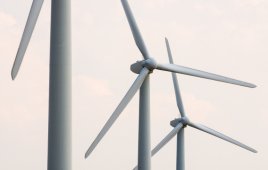This article comes from the Fraunhofer Research News
Wind turbines have a design life of 20 years. The rotor blades must be regularly inspected at least once every four years to verify their structural integrity. This type of work is performed by industrial climbers. But the problem with inspecting offshore installations is that access is only possible when wind and weather conditions permit. This makes it very difficult to plan inspection visits. In the Thermoflight research project, Fraunhofer scientists are working together with industrial and research partners to investigate alternative inspection methods. The use of offshore drones equipped with thermal imaging cameras in combination with acoustic monitoring systems could potentially improve maintenance efficiency and help reduce downtime.
Continuous structural health monitoring (SHM) of rotor blades contributes significantly to the overall cost-efficiency of wind energy turbines. When the rotor is turning, the blade tips can reach a speed of 300 to 350 km/h – as fast as a Formula-1 racing car. Rotor blades deliver their best aerodynamic performance when the boundary layer of wind flows smoothly over the airfoil without causing wake effects. Even the slightest surface damage can generate turbulence, resulting in lower efficiency. For a wind turbine, this means diminished output, less cost-effective operation, and a shorter service life.
The extreme conditions out at sea cause materials to degrade much faster than on land. Specific stress factors include greater exposure to UV radiation, high wind speeds and salt-laden air. The industrial climbers who carry out the regular inspections check for signs of delamination and other forms of damage by tapping on the structure and examining its visual appearance. The poor accessibility of offshore wind farms and the unpredictability of maritime weather conditions make it difficult to plan the deployment of maintenance teams, with a corresponding impact on operating costs.
A typical example is the case in which inspection workers are repeatedly called out but then sent home again because the weather window is too short to permit high-altitude work. Wind farm operators are therefore looking for alternative structural health monitoring methods that are equally as reliable as regular inspections by industrial climbers. “What we need are flexible methods that allow wind-turbine rotor blades to be inspected in situ in a minimum of time and without long preparation, and yet still deliver results that are as reliable and conclusive as those obtained when inspections are carried out by industrial climbers,” says Dr.-Ing. Holger Huhn, director of research and development at WindMW Service, the company coordinating the project.

Static testing of the trailing edge of a rotor blade. Acoustic emission sensors were able to detect and locate all defects.
Fatigue tests show convincing results
These issues are being addressed in a concept study by researchers from the Fraunhofer Institute for Wind Energy and Energy System Technology IWES in Bremerhaven together with WindMW Service GmbH, the Bremen Institute for Metrology, Automation and Quality Science (BIMAQ), and Deutsche WindGuard Engineering GmbH. In two parallel approaches, their goal is to reduce wind turbine downtime and perform maintenance with fewer personnel. One approach involves the use of drones in combination with mobile thermography technology; the other employs an acoustic emission monitoring system. The acoustic emission measuring system integrated with the rotor blade serves as an early warning system by detecting internal damage, for example at the root of the rotor blade. The thermal imaging camera, on the other hand, detects surface damage, such as that caused by rain erosion. Fraunhofer IWES is optimizing the non-destructive acoustic emission monitoring system for the inspection of rotor blades. Acoustic emission and piezoelectric sensors are attached to the inner surface of the rotor blades in structurally relevant areas – especially at known weak points. The measurement computing device that collects and analyzes the sensor data is integrated into the rotor hub.

The thermographic image of a rotor blade was provided by the University of Bremen, and the Bremen Institute for Metrology, Automation, and Quality Science.
For the full article: https://goo.gl/M2QSnT
Filed Under: Blades, O&M




